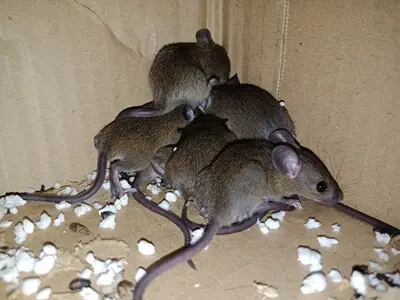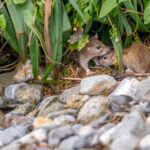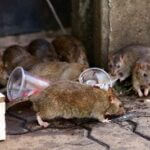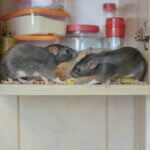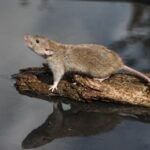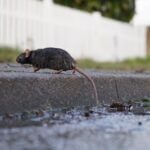Rats need a place to sleep to avoid detection. They build nests with paper, plastic, leaves, insulation, and other materials in a secluded, quiet, warm, dry, and safe location.
Once the nest is established, rats will be reluctant to abandon it.
Rats leave their nests to forage for food and water before returning. They then form nearby nests to raise their young and develop colonies.
Rats will only abandon a nest if it is destroyed or their safety has been compromised. Even then, rats may repair it and live there if you don’t return.
Rats are dedicated to their favored nest. They’re careful when choosing a spot, prioritizing safety, warmth, and access to food and water.
Do Rats Stay in One Place?
Rats are known to be more neophobic (afraid of new things) than most animal species. So, they’ll stay in one place as long as circumstances allow.
Since rats prefer to live in familiar areas, they mark their pathways with scent marks. They use these scent marks to follow the same routes whenever they temporarily leave the nest.
This evolutionary trait keeps rats safe from other aggressive rats and predators. It prevents them from getting lost, enables them to find secure locations for food, and allows them to build large colonies.
Like many mammals, rats are social animals that prefer to live with other rats. These nests aren’t just their sleeping places and hideouts but where female rats wean their young.
Rats only move to different nests if the old one is destroyed or if they have to look for food in a remote area. If food and water are scarce, rats will reluctantly leave.
They’ll seek a new place to build a nest, and once they’ve found a spot, they’ll only rest there. The cycle of rats staying in one place begins all over again.
That’s not to say that rats aren’t explorers. Usually, rats leave their nests at dusk to forage for food. They’ll return at dawn to sleep, hide leftover food, and play with their offspring.
Why Do Rats Keep Coming Back to The Same Place?
Rats are dedicated to their nests because they are thorough when choosing places to nest. They won’t settle down to live and raise their young unless the location is quiet and secluded.
Here are the factors that make rats keep coming back to the same place:
Warmth
Rats look for warm places to nest, not only for their comfort but also for survival. According to the University of Sadat City, low temperatures can make rats sick, leading to hypothermia and death.
Baby rats (pups) are even more vulnerable, encouraging their mothers only to choose nests that can sustain them. Mother rats are more likely to hunker down in one place and keep returning.
This means that infestations are more common in the winter and rainy seasons. The cold conditions may force them to seek shelter indoors.
Preferred areas include attics, basements, and inside walls.
Safety
According to Frontiers in Ecology and Evolution, rats preferred to remain in one home area for security reasons. It’s easier for them to reach safety when they know all the different escape routes.
Rats are territorial, so they may avoid entering the territories of other rats to prevent clashes.
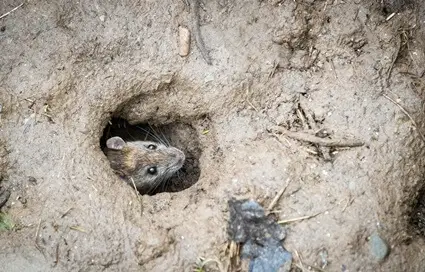
Food
Rats are among the least picky eaters in the animal kingdom.
Anything from rotten food to raw grains and cereals, vegetables, natural fabrics, soap, and dog poop can serve as food for hungry rats. Brown rats are especially ravenous.
If the rats in your home have discovered a secret hideaway close to food or provide safe passage to nourishing food, they’re unlikely to leave voluntarily.
Rats can live off almost anything, so it’s difficult to starve rats out.
Water
Rats like nesting places close to water, providing a reliable source of hydration.
Rats will nest close to the following water sources:
- Leaking taps, pipes, and roofs.
- Dripping sprinklers.
- Pets’ water bowls.
- Damp, wet places in garages.
- Rain barrels.
Rats need lots of water to stay hydrated. Unlike mice, they can’t fully satisfy their thirst with moisture from food. On hot days, the average water consumption for an individual rat is 24-35 ml.
The average water consumption is slightly lower, about 10 ml per 100 grams of body weight.
Nesting Materials
Rats may keep coming back to an area if they have nesting materials, such as the following:
- Newspapers.
- Garbage.
- Old fabrics.
- Insulation.
This is partly because rats aim to minimize effort when building their nests. Most rats are small, so carrying all the materials they need to create a nesting area can take days or weeks.
Also, places that have the materials lying about are often warm.
What Happens If You Disturb a Rat’s Nest?
If a nest is disturbed, rats perform repairs and go about their daily lives.
However, rats with young pups will be more cautious. Due to the elevated risk, they’ll move their pups to a new location when they notice the nest has been interfered with.
If you keep disturbing the nest, rats will understand that their cover is blown and move to another area. Destroying a rat’s nest won’t drive them from your home, so they’ll build another nest nearby.
How Do You Know if Rats Are Gone?
If you’ve disturbed the nest and the rats haven’t returned, you may assume they’ve abandoned your home. However, this is rarely the case.
This usually occurs after professional extermination or the arrival of a ratting animal, such as a schnauzer or ferret. To find out whether the rats are gone, check for the following:
- Scratching, screaming, and screeching sounds at night.
- Strong urine smell (ammonia).
- Gnawing marks on wood, food packaging, and wires.
- Greasy dirt stains on walls and ceilings.
- Sausage-shaped droppings that are glossy rather than dull-colored.
If you stop noticing these signs altogether, you can take it that the rats have vacated their nest. The most effective test involves spreading talcum powder in places you suspect that rats pass through.
If there are still rats around, you’ll find a trail of footprints and droppings the following day. Rats return to the same nest and use the same paths, so even if you can’t see them, this will reveal their location.

